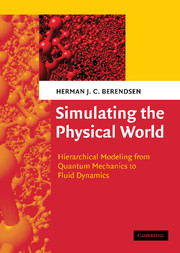Book contents
- Frontmatter
- Contents
- Preface
- Symbols, units and constants
- Part I A Modeling Hierarchy for Simulations
- Part II Physical and Theoretical Concepts
- 12 Fourier transforms
- 13 Electromagnetism
- 14 Vectors, operators and vector spaces
- 15 Lagrangian and Hamiltonian mechanics
- 16 Review of thermodynamics
- 17 Review of statistical mechanics
- 18 Linear response theory
- 19 Splines for everything
- References
- Index
16 - Review of thermodynamics
Published online by Cambridge University Press: 05 June 2012
- Frontmatter
- Contents
- Preface
- Symbols, units and constants
- Part I A Modeling Hierarchy for Simulations
- Part II Physical and Theoretical Concepts
- 12 Fourier transforms
- 13 Electromagnetism
- 14 Vectors, operators and vector spaces
- 15 Lagrangian and Hamiltonian mechanics
- 16 Review of thermodynamics
- 17 Review of statistical mechanics
- 18 Linear response theory
- 19 Splines for everything
- References
- Index
Summary
Introduction and history
This book is not a textbook on thermodynamics or statistical mechanics. The reason to incorporate these topics nevertheless is to establish a common frame of reference for the readers of this book, including a common nomenclature and notation. For details, commentaries, proofs and discussions, the reader is referred to any of the numerous textbooks on these topics.
Thermodynamics describes the macroscopic behavior of systems in equilibrium, in terms of macroscopic measurable quantities that do not refer at all to atomic details. Statistical mechanics links the thermodynamic quantities to appropriate averages over atomic details, thus establishing the ultimate coarse-graining approach. Both theories have something to say about non-equilibrium systems as well. The logical exposition of the link between atomic and macroscopic behavior would be in the sequence:
(i) describe atomic behavior on a quantum-mechanical basis;
(ii) simplify to classical behavior where possible;
(iii) apply statistical mechanics to average over details;
(iv) for systems in equilibrium: derive thermodynamic; quantities and phase behavior; for non-equilibrium systems: derive macroscopic rate processes and transport properties.
The historical development has followed a quite different sequence. Equilibrium thermodynamics was developed around the middle of the nineteenth century, with the definition of entropy as a state function by Clausius forming the crucial step to completion of the theory. No detailed knowledge of atomic interactions existed at the time and hence no connection between atomic interactions and macroscopic behavior (the realm of statistical mechanics) could be made.
- Type
- Chapter
- Information
- Simulating the Physical WorldHierarchical Modeling from Quantum Mechanics to Fluid Dynamics, pp. 423 - 452Publisher: Cambridge University PressPrint publication year: 2007



